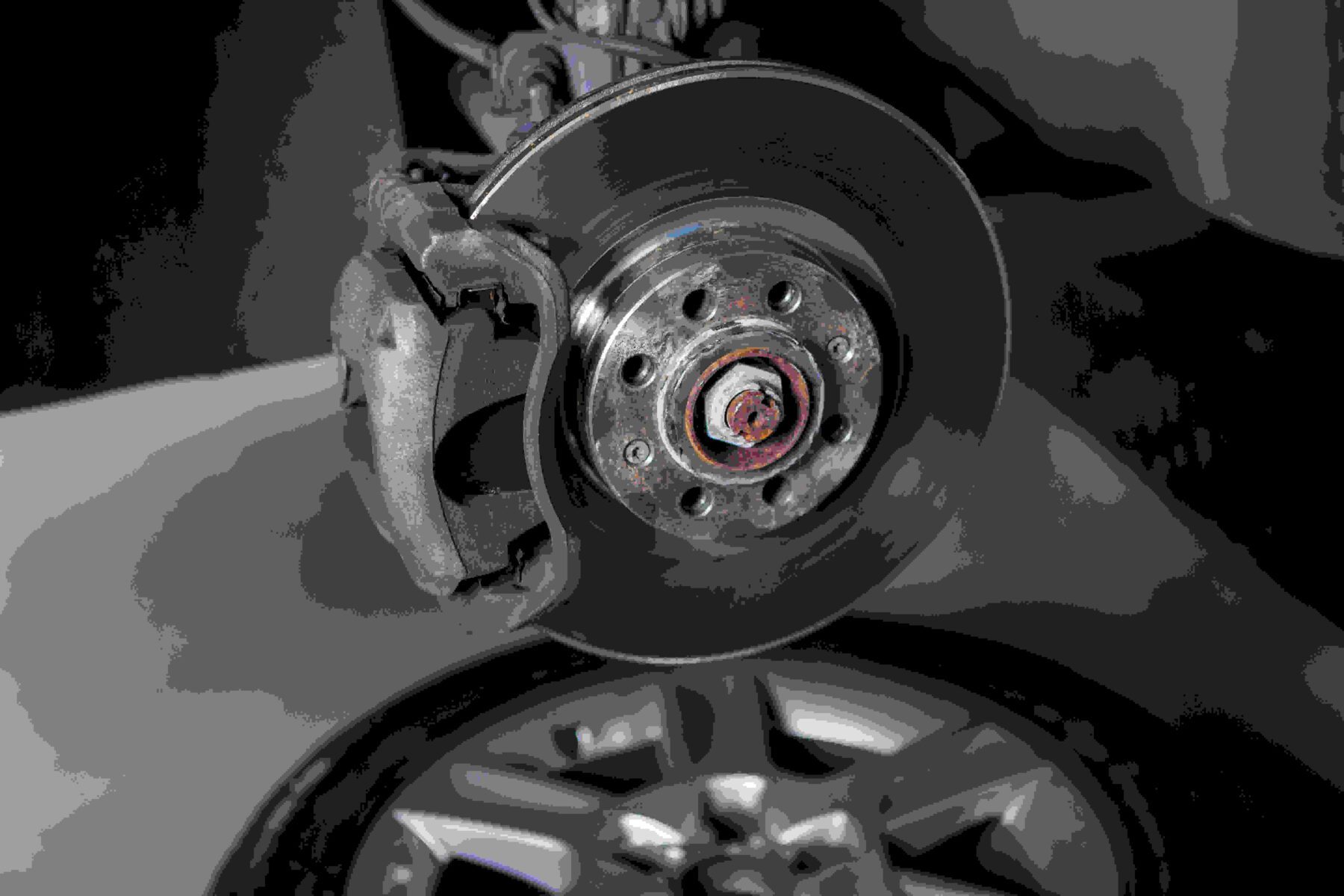At Burj Malabar Auto Maintenance, we understand how concerning it is when your car starts to shake or vibrate as you hit the brakes at high speeds. This kind of brake shudder is more than just a nuisance – it can signal underlying mechanical issues that need attention. Your brakes are one of the most important safety systems in your vehicle, so any shaking during braking should not be ignored. In Sharjah’s fast-paced driving conditions and hot climate, brake problems can be especially noticeable, as high-speed driving and frequent braking put significant stress on your car’s components. In this article, we’ll go over the common reasons a car might shake while braking at high speeds and explain what solutions can address each cause. We’ll also outline how we can help you resolve these issues quickly at our Sharjah service center, so you can get back to smooth and safe driving.
Common Causes of Car Shaking When Braking at High Speeds
When a vehicle shakes upon braking, it’s usually due to a problem in the braking system or related parts that connect your wheels to the road. Below are some of the most common causes of a car vibrating or shuddering when you brake at speed:
- Warped Brake Rotors: Over time and heavy use, the brake rotors (the metal discs that your brake pads clamp onto) can become warped or uneven due to intense heat and wear. A rotor with an uneven surface will cause the brake pads to grip inconsistently, leading to vibration in the car and often a pulsating brake pedal. Warped front rotors typically make the steering wheel shake when braking, while warped rear rotors might make the whole car vibrate. This is a very common culprit for high-speed braking shakes.
- Worn or Glazed Brake Pads: Brake pads wear down with normal use. If pads become very thin or unevenly worn, they can cause vibrations when you apply the brakes. Often this is accompanied by a high-pitched squealing noise from the wear indicators. Glazed brake pads (pads that have been overheated and hardened) can also grab and slip erratically on the rotor, resulting in a shaking feeling. In either case, it’s likely time to get the brake pads replaced.
- Stuck (Seized) Brake Caliper: The brake caliper is the component that presses the pads against the rotor. If a caliper’s slide pins or pistons seize up due to corrosion or lack of lubrication, the caliper may not release properly. A sticking caliper can cause one brake to clamp harder or drag on the rotor, leading to the car shaking and pulling to one side during braking. You might also notice a burning smell from an overheating brake if a caliper is stuck.
- Unbalanced or Worn Tires: Issues with your wheels and tires can also cause vibrations. If your tires are unevenly worn or your wheels are out of balance, the car may shake at certain speeds even when not braking. This can become especially noticeable during braking at high speeds because the slight wobble from an unbalanced tire is amplified when you slow down quickly. Likewise, flat spots on tires or damage to the tire structure can cause a thumping vibration when braking.
- Wheel Alignment Problems: When your car’s wheel alignment is off, it means the wheels are not pointing exactly in the proper directions. Poor alignment often causes the vehicle to pull to one side and can lead to uneven tire wear. Severely misaligned wheels or wheel wobble (like a bent rim) might contribute to vibrations when braking, since the tires aren’t tracking straight and stable. Additionally, alignment issues put extra stress on suspension components, which can then cause shaking if those parts wear out.
- Worn Suspension Components: Your suspension and steering system (including parts like ball joints, tie rod ends, control arm bushings, and wheel bearings) must be in good condition to keep the car stable. If these components are worn or loose, you may feel vibrations and shuddering during braking – especially from high speed – because the suspension cannot hold the wheels firmly against the road. For example, bad ball joints or bushings can let the wheel oscillate when braking, causing a shake. In some cases, even a failing wheel bearing can produce a vibration when brakes are applied due to the slight wobble in the wheel’s rotation.
Here is a quick comparison of the major causes of brake vibration and how to solve them:
| Cause of Shaking | What It Means (Why it Causes Vibration) | Solution (How to Fix It) |
|---|---|---|
| Warped Brake Rotors | Rotors are unevenly worn or heat-distorted, so brake pads grip inconsistently, causing a pulsation and shake when braking at speed. | Resurface the rotors if possible (machine them flat), or replace with new rotors. Always install fresh brake pads with new/turned rotors to ensure proper contact. |
| Worn/Glazed Brake Pads | Brake pads are excessively thin, uneven, or hardened from heat, so they can’t grip the rotor smoothly (often accompanied by squealing). | Replace the brake pads with a new set. Also inspect rotors – if they are scored or glazed, resurface or replace them so the new pads wear evenly. |
| Stuck Brake Caliper | A caliper is seized or not sliding freely, causing one brake to apply unevenly or drag. This imbalance makes the car vibrate and often pull to one side. | Service or replace the caliper. Clean and lubricate caliper slide pins, or install a new caliper unit if needed. Afterward, the braking force will be even on all wheels. |
| Unbalanced/Worn Tires | Tires are out of balance or have uneven tread wear/bulges, leading to a wobble that becomes noticeable as vibration, especially during high-speed braking. | Perform wheel balancing and rotate or replace tires if they are damaged or very worn. Ensure tires are inflated to proper pressure. This will eliminate speed-related shakes. |
| Poor Wheel Alignment | Wheels are misaligned (pointing in different directions), which can cause the car to wander or tires to wear unevenly – instability that can manifest as shaking during braking. | Get a professional wheel alignment. Correcting the alignment will improve stability and prevent uneven tire wear (a hidden cause of vibrations). |
| Worn Suspension Parts | Ball joints, tie rods, bushings, or wheel bearings are loose or damaged, so the wheel jounces or vibrates under braking forces instead of staying firmly in line. | Replace any worn suspension or steering components and then do an alignment. New parts will restore stability, and alignment ensures everything runs straight and true. |
How to Fix a Car That Shakes When Braking
Fixing a brake vibration issue starts with a thorough inspection to pinpoint the exact cause. Because multiple factors can lead to shaking, it’s important to systematically check the brakes, wheels, and suspension. Here are the key solutions and repairs that will resolve most cases of a car shaking when braking at high speeds:
- Brake Rotor Replacement or Resurfacing: Since warped or uneven rotors are a top cause of brake shudder, the primary fix is to either resurface (machine) the rotors or replace them with new ones. Resurfacing involves grinding a thin layer off the rotor faces to make them perfectly flat again. This can cure minor warping, but it only works if the rotor has enough thickness left and the warping isn’t severe. Keep in mind, resurfacing is often a temporary fix – eventually rotors will need full replacement when they wear too thin. In many cases, especially if the rotors are deeply warped or cracked, installing new rotors is the safest solution. Whenever rotors are resurfaced or replaced, it’s best practice to install new brake pads at the same time so that the pads and rotors wear in together evenly. This ensures maximum contact and smooth braking.
- Install New Brake Pads: If your brake pads are worn out or glazed, replacing them is an important part of the fix. Fresh brake pads will provide proper friction and stop any squealing or metal-on-metal grinding that can come with worn pads. As mentioned above, new pads should ideally go on a smooth rotor surface. If pads wore down to the point of causing rotor damage (for example, the pad’s metal backing scored the rotor), the rotor will need attention too. High-quality brake pads are recommended, as cheap pads can wear out faster or even contribute to vibrations by leaving uneven deposits on the rotor.
- Service the Brake Calipers: It’s crucial to ensure the brake calipers are working freely on all wheels. As part of the solution, a mechanic will inspect the calipers and their guide pins. Cleaning and lubricating the caliper slide pins can often solve a sticking caliper issue. If a caliper piston is found seized or leaking, the caliper may need to be rebuilt or replaced. After servicing, both front brakes should apply evenly (same for rear brakes), which will stop the car from pulling or shaking due to one side braking harder.
- Wheel Balancing and Tire Replacement: If the inspection reveals that wheel imbalance or bad tires are contributing to the shake, the solution is to balance the wheels and fix any tire issues. Wheel balancing adds small weights to your rims so that each wheel-tire combination spins without wobble. This should be done whenever you feel vibration at higher speeds or after replacing tires. Additionally, any tire that is worn unevenly, has a bulge, or is out-of-round should be replaced to ensure a smooth ride while braking and accelerating. Properly balanced and healthy tires will eliminate a lot of the trembling you feel in the steering wheel or chassis.
- Alignment and Suspension Repairs: To address alignment or suspension-related vibration, the wheels should be realigned and any worn parts replaced. A computerized wheel alignment will set your vehicle’s wheel angles back to manufacturer specifications, correcting any pulling issues and preventing the kind of uneven tire wear that leads to vibrations. Along with alignment, worn suspension components identified during the inspection (such as loose tie rod ends, ball joints, or bushings) should be replaced. Doing so will tighten up the vehicle’s handling. When the suspension and alignment are in good shape, your car will track straight and brake without shudder. This not only fixes current vibrations but also helps prevent future brake problems by ensuring even pressure and contact when you brake.
Preventive Tips: To avoid brake vibration problems, it helps to practice good driving and maintenance habits. Try to avoid slamming on the brakes at highway speeds unless necessary – sudden high-speed stops create lots of heat that can warp rotors. When driving down long descents (for example, if you venture to hilly areas beyond Sharjah), use engine braking and don’t ride the brakes constantly to prevent overheating. Make sure to service your brakes periodically: replace pads before they get too thin, and flush brake fluid on schedule to keep calipers working properly. Regular tire rotations, balancing, and alignment will also contribute to a vibration-free ride. By being proactive, you can keep your braking system in top shape and catch issues early before they turn into severe shaking problems.
Professional Brake Inspection and Repair in Sharjah
If you’re in Sharjah and your car is shaking when you brake, we’re here to help diagnose and fix the issue. At Burj Malabar Auto Maintenance, our experienced technicians will perform a comprehensive brake inspection to find out exactly what’s causing the vibration. We’ll check the condition of your brake pads and rotors, measure rotor thickness and runout, and ensure the calipers are functioning correctly. We also examine your tires, wheel balance, and suspension components, because a thorough approach is key to pinpointing the problem.
Once we identify the cause, we will explain the recommended repairs to you in clear terms. Whether your car needs new brake rotors, a set of brake pads, caliper servicing, or just a wheel balancing and alignment, we’ve got you covered. Our Sharjah workshop is equipped with advanced tools to resurface rotors (if suitable) or replace parts with high-quality OEM components. As a full-service auto maintenance center, we handle everything from brake fixes to suspension repair and wheel alignment in-house – so you can solve the shaking issue all in one stop.
At Burj Malabar Auto Maintenance, our priority is your safety and satisfaction. We pride ourselves on honest diagnostics, fair pricing, and getting the job done right the first time. In fact, we offer free pick-up and delivery of your car anywhere in Sharjah or Dubai, making it convenient to get your brakes serviced without disrupting your day. Our team will road-test your vehicle after repairs to ensure that the braking is silky smooth and the vibration is gone. You’ll drive away with confidence that your car can stop safely, even from high speeds on the highway.
Smooth Braking for Safe Driving
In summary, a car that shakes when braking at high speeds is giving you an important warning sign. It’s more than just an annoyance – often it indicates worn or damaged parts (like brake rotors, pads, or suspension components) that should be addressed promptly. Ignoring the problem can lead to more serious brake failure or unsafe driving conditions. The good news is that the causes of brake vibrations are well understood, and with the right fixes – from replacing warped rotors to balancing your wheels – your car can be restored to smooth, stable braking performance.
Don’t put up with a shaky, wobbly car when stopping. By taking action to fix the issue, you’ll ensure your vehicle remains safe to drive for you and your passengers. If you’re experiencing this problem in Sharjah, we invite you to visit Burj Malabar Auto Maintenance or give us a call. Our expert team will be happy to eliminate those vibrations and get your brakes back to peak condition. With proper care and timely repairs, you can enjoy confident, smooth braking on every drive – keeping you safer on the road.



